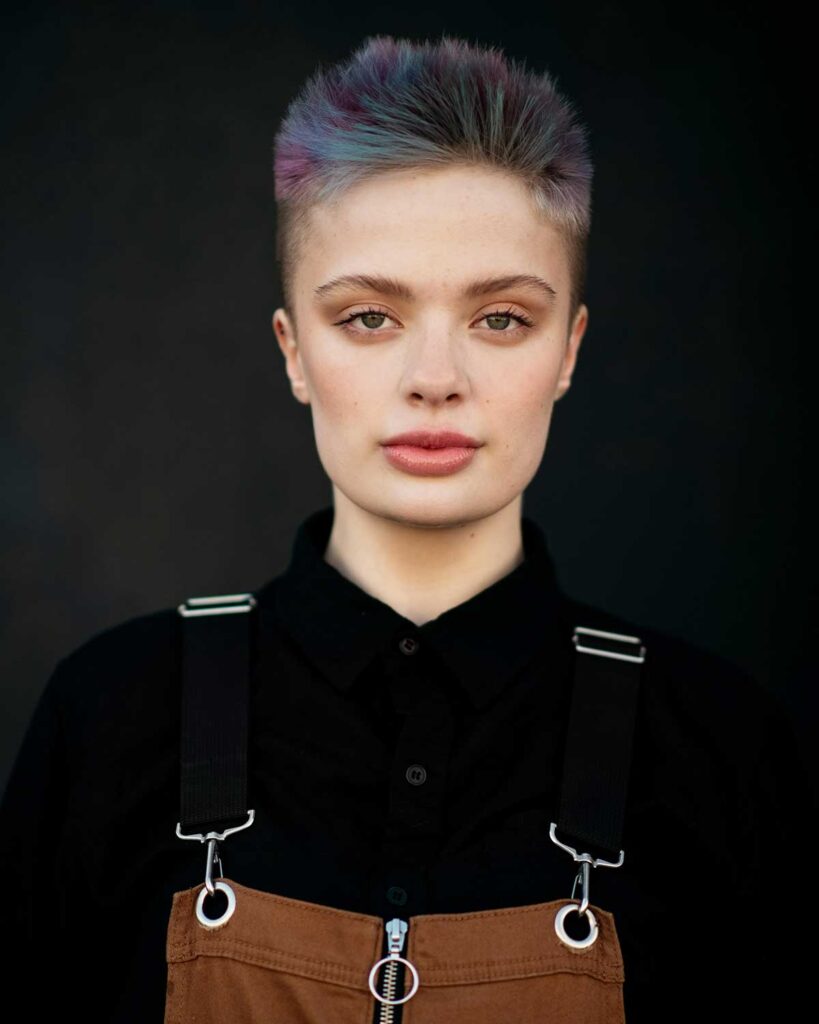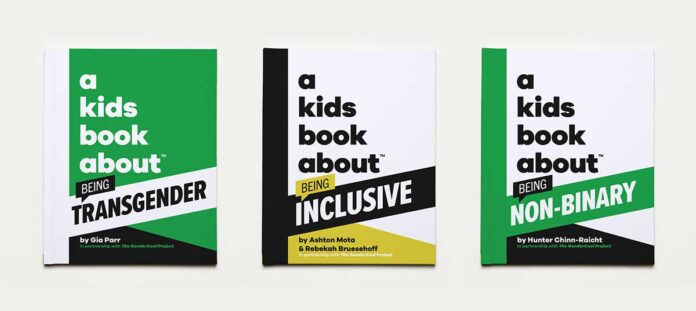Fifteen-year-old Hunter Chinn-Raicht, who is non-binary, knows that the term “non-binary” isn’t always understood. “This is a new word and it’s super confusing for a lot of people, especially people that weren’t brought up with it,” they told me in an interview. They hope to dispel some of that confusion through a new book they’ve written, one of a set of three titles by “champions” of the GenderCool Project, a youth-led movement of teens who are speaking out to show that transgender and non-binary youth can thrive.
The three books, “A Kids Book About Being Non-binary,” by Chinn-Raicht, “A Kids Book About Being Transgender,” by Gia Parr (age 17), and “A Kids Book About Being Inclusive,” by Ashton Mota (age 16) and Rebekah Bruesehoff (age 14), are aimed at children ages 5 to 9, but written by the teen champions. All three are part of the lauded A Kids Book About (AKBA) series (named to Oprah’s Favorite Things list in 2020), which began with “A Kids Book About Racism,” and continues with volumes on belonging, feminism, gratitude, cancer, and other important topics that can be challenging to discuss.

In each volume, the teens talk directly to younger readers as they share their personal stories and illuminate the core concepts of the book. Like the rest of the AKBA books, the GenderCool ones use bright backgrounds and a variety of fonts rather than pictures, keeping the focus on the words and giving the books a conversational feel. The books are also geared towards generating new conversations, and all note, “This book is best read together, grownup and kid.”
To create their book, Chinn-Raicht sat down for a five-hour-long virtual workshop with the AKBA team “to get the breakdown of the manuscript,” followed by a series of shorter video calls to fine tune the details. They also had a collective call with many of the 18 GenderCool champions, who offered their thoughts on what should be in all three books.
Chinn-Raicht thought it would be “super helpful” to include their own experience along with some definitions of words, so that “it won’t be so like a shell shock” for children who may hear someone say, “Hi, my name is Hunter, and I use they/them pronouns.” This would help young readers “have a basis of learning and know the questions to ask when someone says something you’re unsure about.”
Chinn-Raicht begins the book by introducing themselves and their pronouns and noting “I’m non-binary and I’m a dancer.” They then observe that when dancers perform in pairs, the pairs usually consist of a boy and a girl, but “Because I’m non-binary, I get to play both roles and can partner with whomever I choose” — a lovely way to emphasize the positive aspects of being non-binary. They go on to explain what being non-binary means to them and to share the various ways they express their gender, like starting the school day in traditionally feminine clothes and ending it in traditionally masculine ones. At the same time, they emphasize that “Non-binary means something different to everyone!” For those who are struggling to understand gender identity and use the proper words, they offer assurance, writing, “It takes a lot of courage to mess up and keep trying!”
Chinn-Raicht said their favorite parts of writing the book were around school topics, because they often get questions about how their teachers and classmates responded to their coming out as non-binary. Chinn-Raicht explained to me, “I just told the teacher and my classmates started realizing, ‘Oh that’s your name now? Cool.’ And they did their best even if they didn’t understand it.”
They are particularly grateful to their Spanish teacher, who found ways to use gender neutral names, although Spanish words normally each have genders. Chinn-Raicht hadn’t asked the teacher to do that, but “I thought it was the coolest thing that I didn’t have to ask to be accepted…. It just felt so nice.”
Even though this is their first book, Chinn-Raicht has experience educating people about non-binary identities and other LGBTQ topics. They have two moms, who “understood the whole sexuality thing,” but “when it came to gender, it was a little bit different, because I had to explain all the new terms,” they said. Their moms have been very supportive, however, and one even made the connection that led to Chinn-Raicht becoming a GenderCool champion.
When I asked what further advice they might have for non-binary children, Chinn-Raicht elaborated on the message of the book, saying, “I know it’s challenging when people don’t get it right. Having to stand up for yourself daily and put yourself out there can feel so scary, but I promise you it will get better. You will find the people that respect you, respect your being, respect your energy and your pronouns, and once you do, you’ll just feel so good being in your true body and your true form. It’s okay to be struggling and it’s okay to be different right now. It’s just a shifting time, and that’s cool.”
Chinn-Raicht’s book and the other two GenderCool titles, however, just might help things get better a little faster for transgender and nonbinary children. Find all three books at akidsbookabout.com and learn more about the GenderCool Project at gendercool.org.
Dana Rudolph is the founder and publisher of Mombian (mombian.com), a GLAAD Media Award-winning blog and resource directory, with a searchable database of 700+ LGBTQ family books, media, and more.

